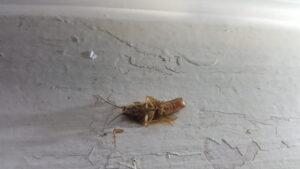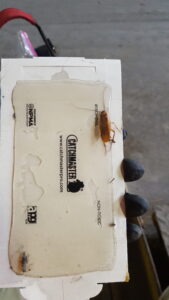Cockroaches
About Cockroaches
With their two long antennae and hairy looking legs, cockroaches are the most well-known pest and the pest with the biggest “Ick!” factor.
The Western United States is home to three main species of roaches. The most common is the German cockroach. They are frequently found indoors, in kitchens, apartments, multi-family housing, food  processors, employee lockers, and many other places with easy access to human food. A German cockroach infestation can be very difficult to eliminate because they are small and hide in tiny cracks and crevices. They are also scavengers and will eat almost anything, including human waste.
processors, employee lockers, and many other places with easy access to human food. A German cockroach infestation can be very difficult to eliminate because they are small and hide in tiny cracks and crevices. They are also scavengers and will eat almost anything, including human waste.
The most well-known specie is the American cockroach. They are the largest of the cockroach family that people encounter and spend most of their life in the sewer and will travel up sewer lines to permeate a facility. During their life, they are in close contact with human trash and carry very dangerous pathogens like salmonella. They can be found in many commercial facilities like hospitals, kitchens, distribution centers, storage warehouses, to name a few.
The third species is the Turkistan cockroach. They are primarily an outside dweller in warmer climates and are associated with moisture and other organic material but will breach a facility in search of food. Turkistan cockroach issues are increasing because they out compete the other two species as they reproduce at higher rate, making an infestation even more difficult to eliminate. Like the American cockroach, they can be found in hospitals, commercial facilities, and distribution centers.
Our technicians are trained to identify all species of cockroach and create programs tailored to combat their specific pest pressure.
Key Risks
German cockroaches produce allergens that can build up in multi-family housing irritating those with asthma.
Food processing facilities can fail their audits due to contamination from cockroaches.
Many roaches are in constant contact with sewage and other unsanitary areas and carry many pathogens that can cause salmonella and other diseases.
Health Risks & Prevention
Like most living creatures on the planet, cockroaches are in search of water, food, and a safe place to live. Their search for food most often leads them to kitchens or food processing facilities where they will crawl across food preparation surfaces and can pass along dangerous pathogens and diseases.
Due to their small size, an infestation can happen before you are even aware, placing a greater emphasis on a preventative practice. One of the easiest methods of preventing a roach infestation is sanitation. Practices such as cleaning up any food crumbs, grease, deposits, or other organic material along the perimeter of a facility, can remove opportunities for them to find food or water.
Contact Sprague for more information on how we can help protect your facility from cockroach contamination.
Did you know?

Sprague Solutions
-
Exclusion
-
Physical exclusion is the best method of preventing cockroaches from the exterior, especially in warmer climates. Door sweeps are a very common method of excluding. Other methods for cockroaches that may be in the sewer include filling up the p-trap in drains withers, so that they cannot break in and build nests around the water source.
-
Sanitation
-
Sanitation is very important in preventing a cockroach infestation. Cockroaches are always on the hunt for places where there is access to food. Cleaning up any food crumbs, scraps, grease, food deposits, food waste or any other organic material will remove their food source.
-
Sprays
-
A cockroach spray that kills on contact may seem like a good solution, but they can make an infestation worse. A spray will kill off the roaches that you can see but they will not kill any of the female adolescents and the younger nymphs that are back at the harborage site. Sprays are a short-term solution that does not help prevent more roaches from entering the facility. A bait is a much more effective means at elimination.
-
Bub Bombs
-
Bug bombs or other similar sprays or pesticides should not be used for cockroaches. Bug bombs can irritate the roaches and push them towards deeper harborage areas, or other areas of the structure like a dining room in a restaurant, that can make elimination harder. Bug bombs or fogging also leave no residual and do not penetrate the cracks and crevices where most roaches are hiding.
-
Bait
-
Bait is the best method to eliminate and prevent cockroaches. Bait in a station or placed in cracks and crevices are less likelihood to contaminate other areas of a facility, making them safe for food production areas like a commercial kitchen. Bait also has a multiplication effect. Adult roaches that consume the bait will consume a toxic amount and carry the toxin back to their harborage area transferring the effect onto other roaches and their young.
-
Sticky Traps
-
Sticky traps are used for monitoring cockroach activity. They can provide information like are their numbers increasing or decreasing, are we near a harborage site, what species we are catching, and if insect growth regulators are working. For example, if we are catching females and nymphs, who rarely leave the harborage area, we know that we are close to a harborage site.
-
Dusting
-
Using a pesticide dust is a longer-term solution. Pesticide dust needs to be placed in a position where it will not be disturbed by air currents. One of the most important areas of consideration are locations where the dusting has a potential to encounter humans or any food preparation surface.
-
Door Sweeps
-
Door sweeps are a very effective method of preventing exterior cockroaches from entering a facility by eliminating gaps that they could crawl through.
-
Sanitation Strip
-
A sanitation strip is an effective method of excluding exterior cockroaches from any facility. A 12–18-inch strip of gravel along the base of the building wicks the water away from the facility and prevent organic debris from building up. This deprives the roach from a food and water source and prevents opportunities to penetrate the facility barrier.




